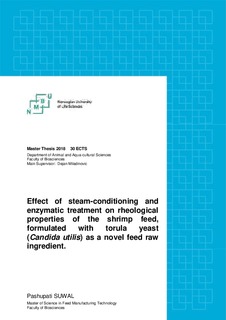| dc.description.abstract | The use of yeast as an alternative source of protein has been in demand as a novel feed ingredient in shrimp feed nowadays. In order to optimize its use, more research and study is required. The objective of this study was to determine the possibility of using yeast as fishmeal replacer and observe the influence on the rheological properties of shrimp diet pellets due to steam conditioning and enzymatic treatment. Diets were formulated with the addition of different percentage of Candida utilis (CU) along with mixed enzymes (protease and endo/exo-1, 3 β- glucanase). The powder mash was compressed into pellets using a single pellet press method. Six experimental diets were formulated for the experiment. These includes: Diet 1 or positive control diet with 0% CU and 0% enzymes, diet 2 or negative control diet with 0% CU but with enzymes and remaining four diets with addition of CU to diet 2 in a percentage of 2.5% (diet 3), 5% (diet 4), 10% (diet 5) and 20% (diet 6) respectively. Rheological characters of these pellets on tensile strength (hardness), water activity (aw), contact angle/wettability of pellets (θc), energy consumption (Pmax) and underwater pellet swelling rate (UPS) were studied. Tensile strength and Pmax were found to be dependent on the quantity of CU as diet 6 has the highest tensile strength and Pmax while diet 2 has the lowest. Although all the diets were found to have aw below 0.5 indicating them as free from microbial growth, diet 5 and 6 contained slightly higher aw enhancing their binding property. The UPS rate was significantly less for pellets with diet 6 from the starting time until the last (observation time was 40 minutes) while diet 2 having the high swelling tendency throughout the test.
The value of the initial water θc was not significant. However, the pellets from diet 6 and diet 1 had the high θc until the observation time of 2 seconds. In the oil phase, the pellets from diet 6 showed the least θc while diet 1 showed the highest θc until the observation time of 20 seconds. A significant positive correlation was observed between aw vs. tensile strength, aw vs. UPS rate and aw vs. water/oil θc. Results showed that the presence or absence of CU in diets containing enzymes influenced rheological characters like tensile strength, Pmax, θc and UPS rate.
Thus, the addition of 20% CU with enzymes replacing fishmeal in shrimp diet pellets shows better results in the study of rheological characters. Further research needs to be performed before the commercial pilot feed production. | nb_NO |

